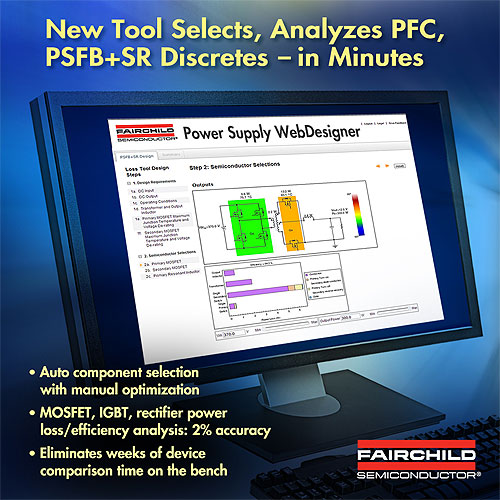Fairchild Semiconductor (NYSE: FCS) has enhanced Power Supply WebDesigner (PSW), an online design and simulation tool that provides complete designs in under a minute to include power train discrete (MOSFET/IGBT/Rectifier) device power loss and efficiency analysis tools.

Intended for 100 W to 3 kW designs as a function of input and output conditions, these new modules provide designers power factor correction (PFC), phase-shifted full-bridge plus secondary side synchronous rectification (PSFB+SR) power train discrete device analysis, and the matrix of device combinations associated with these topologies.
From user-specified electrical and mechanical specifications, the new modules provide an optimum combination of power discrete semiconductors, transformer and inductor design values, as well as a bill of material (BOM). It also provides a dashboard view of the converters system and device power loss, device junction temperature, and further component fine-tuning over the operating conditions.
As with other PSW modules, designers using the tools can accept default recommended values, or spend time optimizing the important details to their unique design needs. They can get quick, accurate estimates on design performance, and refine design choices as they go. The tools also allow them to spend the time to perform detailed simulation analysis and learn the insights of how their design and its hardware prototype will work with higher degree of confidence.
The Power Train Discrete Module consists of a phase-shifted full bridge with secondary side synchronous rectification (PSFB+SR) module and power factor correction (PFC) module. They are easy-to-use, powerful online simulation tools that provide designers:
- An optimized tool that works with the most popular PSFB+SR control ICs on the market (UCC28950 and UCC3895).
- A complete power train discrete device design including selection of the optimum Fairchild MOSFET, IGBT, and rectifier. Users can select the optimum bridge rectifier, MOSFET/IGBT, and power rectifier part numbers (PNs), or let the tools recommend from user-specified system design inputs.
- An optimized power train discrete design targeting power supplies that need PFC and/or PSFB+SR.
- Power train discrete component losses correlated against hardware for highest level of relative accuracy unmatched by equation-based calculation alone.
- The ability to compare different sets of power train discrete combinations within one analysis. The module highlights Fairchilds MOSFET and IGBT technology portfolio which includes SuperFET® MOSFETs, SuperFET® II MOSFETs, SupreMOS® MOSFETs, PowerTrench® MOSFETs and field-stop IGBTs.
- The option to let the tools recommend or fine-tune the power train discrete components, automating a tedious, high-iteration, manual trial-and-error / test-design step, saving valuable time.
- Visual representation of system and major component power loss and efficiency over different line and load conditions, allowing designer to go back into the online design steps to re-balance the system and component loss before prototyping.
These new modules save designers time when evaluating various combinations. Rather than spending the typical one-week-per-combination bench testing time, PSW can simulate each combination quickly and accurately typically ~2 percent difference over line and load conditions between tool and hardware measurement results.
When a design is complete, PSW creates a BOM which can be sent to their procurement department or instantly procure the components online, saving time on documentation or sourcing parts elsewhere. Additionally, they can save their design for future reference or pass the design on to other team members.
Power Supply WebDesigner offers a suite of time-saving tools for designing and optimizing the system and power train. The online tool experience ranges from device to system analysis and simulation that takes minutes. The models, calculations and iterative steps of power supply design are built into the tools. Regardless of the users experience level, the tools will increase effectiveness, efficiency and confidence when designing.
Fairchild Semiconductors
www.fairchildsemi.com


Leave a Reply